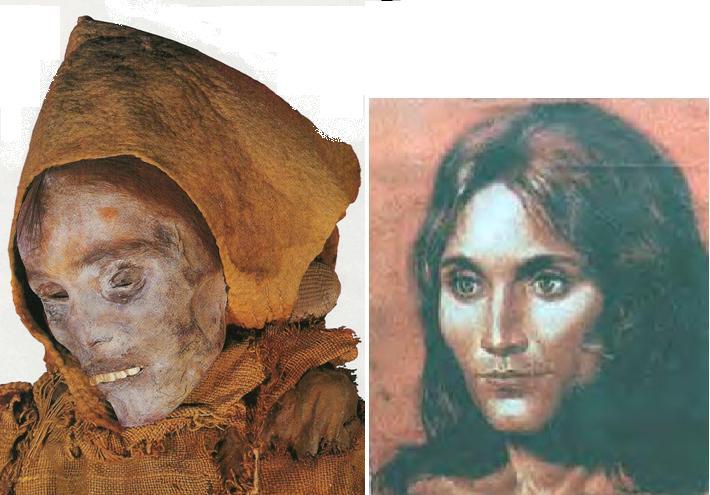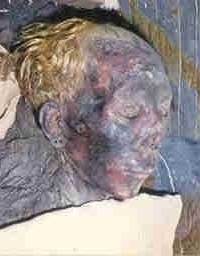Here is something written about the
Tarim Mummies in Wikipedia.
Genetic links
DNA sequence data shows that the mummies had
Haplogroup R1a (Y-DNA) characteristic of western Eurasia in the area of East-Central Europe, Central Asia and Indus Valley.
A team of Chinese and American researchers working in Sweden tested DNA from 52 separate mummies, including the mummy denoted "Beauty of Loulan." The features of the Loulan Beauty have been described as Nordic in appearance. She was approximately 45 years old when she died. By genetically mapping the mummies' origins, the researchers confirmed the theory that these mummies were of West Eurasian descent. Victor Mair, a University of Pennsylvania professor and project leader for the team that did the genetic mapping, commented that these studies were:
...extremely important because they link up eastern and western Eurasia at a formative stage of civilization (Bronze Age and early Iron Age) in a much closer way than has ever been done before.
An earlier study by Jilin University had found an mtDNA haplotype characteristic of Western Eurasian populations with Europoid genes.
In 2007 the Chinese government allowed a National Geographic team headed by Spencer Wells to examine the mummies' DNA. Wells was able to extract undegraded DNA from the internal tissues. The scientists extracted enough material to suggest the Tarim Basin was continually inhabited from 2000 BCE to 300 BCE and preliminary results indicate the people, rather than having a single origin, originated from Europe, Mesopotamia, Indus Valley and other regions yet to be determined.
However, In 2009, the remains of individuals found at a site in Xiaohe were analyzed for Y-DNA and mtDNA markers. They suggest that an admixed population of both west and east origin lived in the Tarim basin since the early Bronze Age. The maternal lineages were predominantly East Eurasian haplogroup C with smaller numbers of H and K, while the paternal lines were all West Eurasian R1a1a. The geographic location of where this admixing took place is unknown, although south Siberia is likely.
It has been asserted that the textiles found with the mummies are of an early European textile type based on close similarities to fragmentary textiles found in salt mines in Austria, dating from the second millennium BCE. Anthropologist Irene Good, a specialist in early Eurasian textiles, noted the woven diagonal twill pattern indicated the use of a rather sophisticated loom and, she says, the textile is "the easternmost known example of this kind of weaving technique."
Mair claims that "the earliest mummies in the Tarim Basin were exclusively Caucasoid, or Europoid" with east Asian migrants arriving in the eastern portions of the Tarim Basin around 3,000 years ago while the Uyghur peoples arrived around the year 842. In trying to trace the origins of these populations, Victor Mair's team suggested that they may have arrived in the region by way of the Pamir Mountains about 5,000 years ago.
Mair has claimed that:
The new finds are also forcing a reexamination of old Chinese books that describe historical or legendary figures of great height, with deep-set blue or green eyes, long noses, full beards, and red or blond hair. Scholars have traditionally scoffed at these accounts, but it now seems that they may be accurate.
Chinese historian Ji Xianlin says China "supported and admired" research by foreign experts into the mummies. "However, within China a small group of ethnic separatists have styled themselves the descendants of these ancient people". Due to the "fear of fuelling separatist currents" the Xinjiang museum, regardless of dating, displays all their mummies both Tarim and Han, together.
Posited origins
Physical anthropologists propose the movement of at least two Europoid physical types into the Tarim Basin. Mallory and Mair associate these types with the Tocharian and Iranian (Saka) branches of the Indo-European language family, respectively.
B. E. Hemphill's biodistance analysis of cranial metrics (as cited in Larsen 2002 and Schurr 2001) has questioned the identification of the Tarim Basin population as European, noting that the earlier population has close affinities to the Indus Valley population, and the later population with the Oxus River valley population. Because craniometry can produce results which make no sense at all (e.g. the close relationship between Neolithic populations in Ukraine and Portugal) and therefore lack any historical meaning, any putative genetic relationship must be consistent with geographical plausibility and have the support of other evidence.
Han Kangxin, who examined the skulls of 302 mummies, found the closest relatives of the earlier Tarim Basin population in the populations of the Afanasevo culture situated immediately north of the Tarim Basin and the Andronovo culture that spanned Kazakhstan and reached southwards into West Central Asia and the Altai.
It is the Afanasevo culture to which Mallory & Mair (2000:294–296, 314–318) trace the earliest Bronze Age settlers of the Tarim and Turpan basins. The Afanasevo culture (c. 3500–2500 BCE) displays cultural and genetic connections with the Indo-European-associated cultures of the Eurasian Steppe yet predates the specifically Indo-Iranian-associated Andronovo culture (c. 2000–900 BCE) enough to isolate the Tocharian languages from Indo-Iranian linguistic innovations like satemization.
Hemphill & Mallory (2004) confirm a second Europoid physical type at Alwighul (700–1 BCE) and Krorän (200 CE) different from the earlier one found at Qäwrighul (1800 BCE) and Yanbulaq (1100–500 BCE):
This study confirms the assertion of Han [1998] that the occupants of Alwighul and Krorän are not derived from proto-European steppe populations, but share closest affinities with Eastern Mediterranean populations. Further, the results demonstrate that such Eastern Mediterraneans may also be found at the urban centers of the Oxus civilization located in the north Bactrian oasis to the west. Affinities are especially close between Krorän, the latest of the Xinjiang samples, and Sapalli, the earliest of the Bactrian samples, while Alwighul and later samples from Bactria exhibit more distant phenetic affinities. This pattern may reflect a possible major shift in interregional contacts in Central Asia in the early centuries of the second millennium BCE.
Mallory and Mair associate this later (700 BCE–200 CE) Europoid physical type with the populations who introduced the Iranian Saka language to the western part of the Tarim basin.
Mair concluded:
"From the evidence available, we have found that during the first 1,000 years after the Loulan Beauty, the only settlers in the Tarim Basin were Caucasoid. East Asian peoples only began showing up in the eastern portions of the Tarim Basin about 3,000 years ago, Mair said, while the Uighur peoples arrived after the collapse of the Orkon Uighur Kingdom, largely based in modern day Mongolia, around the year 842."
__________________
I basically see a lot of fraud occurring here! All this "Europoid" physical type is nonsense. If Iranian Saka speakers were the Mummies, why are they being called Europoid?
In fact the whole articles reeks of racism and a desire to prove that the Tocharians were Europeans and R1a1a is European origin haplogroup!
B. E. Hemphill data is simply ignored as not very credible method.
In fact in the article, the Tarim Basin Mummies are being called blond!!! It is natural that after a long time, hair would start losing its dark color and mummies can appear red-haired. The effort is here to show that in the past, the Central Asian Aryans who lived there were in fact blond European looking people!
It is really a pity that these Europeans are being allowed to explore and write the history according to their own narrative, and even contrary data is used by them to still claim their own narrative. India on the other hand sends no archaeologists overseas.




